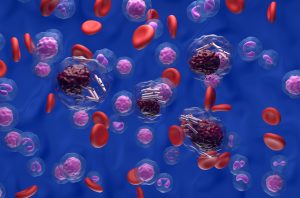
Targeting Treatments for Chronic Lymphocytic Leukemia
Dr. Joel Silver How do myeloma and chronic lymphocytic leukemia (CLL) develop? What are some risk factors associated with those malignancies? A. We don’t know
HIPAA Alert: Potential Data Breach Learn More
Questions on Oncology, Hematology and/or Infusion Clinical Services due to COVID-19 Crisis – CALL 833-698-1623
Important Information for Our Patients Regarding the Coronavirus.
RCCA Providing Area Cancer Patients with Access to Care During Coronavirus Outbreak
RCCA Offering Patients Virtual Visits During Coronavirus Pandemic
Most cancers consist of tumors, or lumps of abnormal cells that grow unchecked by the body. Leukemia, however, is cancer that begins in the marrow of the bones and affects white blood cells, which then carry the disease throughout the body. Because of this, doctors stage leukemia, or describe its progression, differently than with other cancers. In addition, there are four distinct types of leukemia that act and progress differently, leading to several different staging conventions.
Most cancers consist of tumors, or lumps of abnormal cells that grow unchecked by the body. Leukemia, however, is cancer that begins in the marrow of the bones and affects white blood cells, which then carry the disease throughout the body. Because of this, doctors stage leukemia, or describe its progression, differently than with other cancers. In addition, there are four distinct types of leukemia that act and progress differently, leading to several different staging conventions.
Regional Cancer Care Associates offers comprehensive cancer care services throughout Connecticut, Maryland, and New Jersey that can help you understand how leukemia stages work. Our oncologists are expert at monitoring, diagnosing, and effectively treating the disease.
Regional Cancer Care Associates offers comprehensive cancer care services throughout Connecticut, Maryland, and New Jersey that can help you understand how leukemia stages work. Our oncologists are expert at monitoring, diagnosing, and effectively treating the disease.
Because acute lymphocytic leukemia (ALL) involves immature white blood cells originating in bone marrow, doctors describe the disease’s stage by factoring in the subtype of ALL and the patient’s age. Staging is as follows:
B cells are produced and mature in the bone marrow and play an important role in the immune system by recognizing and attacking pa thogens. The stages doctors use to describe this subtype of ALL are:
Similar to B cells, T cells have a role in the immune system as an infection-fighter. T cells are generated in the bone marrow and then move to the thymus (a specialized lymphoid organ in the immune system) to mature. The stages of T-cell ALL are:

Doctors use a method called the French-American-British (FAB) classification to describe cases of acute myeloid leukemia (AML). The eight subtypes are denoted as M0 through M7 based on such factors as the number of healthy blood cells, the size and number of leukemia cells, and genetic changes. The stages are:
Like acute forms of leukemia, chronic lymphocytic leukemia (CLL) occurs in the blood and is classified differently than most types of cancer. The Rai system of classification relies on blood cell counts to track the progression of the disease, while the Binet system tracks the disease’s spread through lymph nodes. There are five stages in the Rai system, typically denoted with Roman numerals. The Binet stages are simply A, B, and C.

Chronic myeloid leukemia (CML) can be classified into three stages, which a doctor can determine by looking at bone marrow and blood tests. The stages are:
No matter what subtype or stage, receiving the correct treatment for leukemia is critical. Regional Cancer Care Associates has a network of specialized cancer care experts spanning 31 locations in Connecticut, Maryland, and New Jersey. Contact us today for more information about leukemia stages, or to make an appointment and get started on your road to recovery.

Dr. Joel Silver How do myeloma and chronic lymphocytic leukemia (CLL) develop? What are some risk factors associated with those malignancies? A. We don’t know

Hematologic cancer, or blood cancer, is one of the most common diagnoses treated at Regional Cancer Care Associates. Blood cancer refers to types like leukemia

Several newer types of therapy have transformed the treatment of chronic lymphocytic leukemia (CLL) in recent years, increasing survival and enhancing quality of life while reducing

Regional Cancer Care Associates is one of fewer than 200 medical practices in the country selected to participate in the Oncology Care Model (OCM); a recent Medicare initiative aimed at improving care coordination and access to and quality of care for Medicare beneficiaries undergoing chemotherapy treatment.